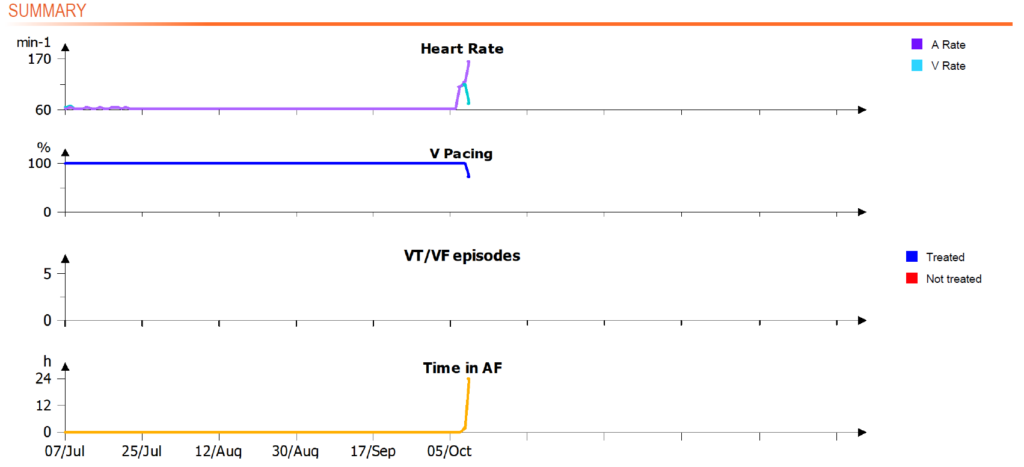Drop in percentage CRT IV
Case Summary
0 of 1 Questions completed
Questions:
Information
You have already completed the case before. Hence you can not start it again.
Case is loading…
You must sign in or sign up to start the case.
You must first complete the following:
Results
Results
Time has elapsed
Categories
- Not categorized 0%
-
Transmission
Like previous cases, we receive a warning that the percentage of V pacing in CRT is less than 80%. The other warnings in the list indicate that the underlying cause is atrial fibrillation. When we look at the real time EGM, we can indeed confirm that the patient is in atrial fibrillation during the transmission with irregular and fast intrinsic ventricular events, caused by conducted atrial fibrillation. As CRT candidates are implanted to resynchronize the heart, they often do not have AV block. During AF episodes, the atrioventricular node is bombarded with many triggers from the atrium, many of those are conducted to the ventricle in an irregular and rapid fashion. The CRT will not trigger biventricular pacing following these very fast atrial events, and will perform a mode switch, meaning that the CRT device will perform biventricular pacing at the lower rate or at the sensor indicated rate. Patients with paroxysmal AF tend to have interruption of CRT during these episodes, but the percentage of biventricular pacing often increases during the episodes as the atrioventricular node is slowing down the conduction while AF continues. We also see this phenomenon in this case, as the initial jump in V-rate curve is decreasing from AF onset to the time of transmission.
Next steps
Paroxysmal atrial fibrillation is associated with loss of resynchronization. The goal should be to recover CRT to over 90-95%. This could be done in multiple ways.
- Rate control: medical therapy using for instance beta blockers may be efficient in slowing down the atrioventricular node, which decreases intrinsic ventricular events detected by the CRT device. In this case, the AF episodes may be sporadic and appear to be associated with a slowing down of the ventricular rate as the episode pursues. On the real time EGM we observe intrinsic ventricular events but they are <100 bpm (>600 ms) giving hope that a rate control strategy can be effective.
- Rhythm control: terminating the AF episode (cardioversion) can be done using medication (such as amiodarone), delivering an external shock or by invasive ablation procedure. Medication may not be successful and procedures may be difficult to plan on short notice. This is why in the context of remote monitoring, when patients are often not yet symptomatic, rate control is often chosen as the initial approach. But rhythm control is more effective in the long run. Ablation procedures are getting more and more popular, and most commonly include isolation of the pulmonary veins by use of catheters.
- Watch and wait approach: clinical studies (such as the ACWAS trial)show that AF episodes are often self-terminating and medication or invasive procedures are in many cases not required. In the context of remote monitoring, one may choose to closely monitor the situation, guided by patient symptoms, favoring spontaneous resolution of the problem. This approach may require patient participation such as manual transmissions or enrollment into heart failure monitoring programs.
- Ablation of the His bundle. Initally, His bundle ablation was not a very popular approach as destroying the atrioventricular connection renders the patient completely pacemaker dependent. But evidence is increasing in favor of His bundle ablation as it is a relatively simple procedure and extremely effective against drops in CRT during paroxysmal but also persistent or permanent AF. In contemporary clinical practice, His bundle ablation is now a common approach in the elderly or in cases where AF ablation is considered low-success or high-risk.
In this patient, the dose of betablockers were increased and the patient was recommended to meet with his cardiologist in order to discuss AF ablation.
- 1
- Current
- Review / Skip
- Answered
- Correct
- Incorrect
-
Question 1 of 1
1. Question
CorrectIncorrect


